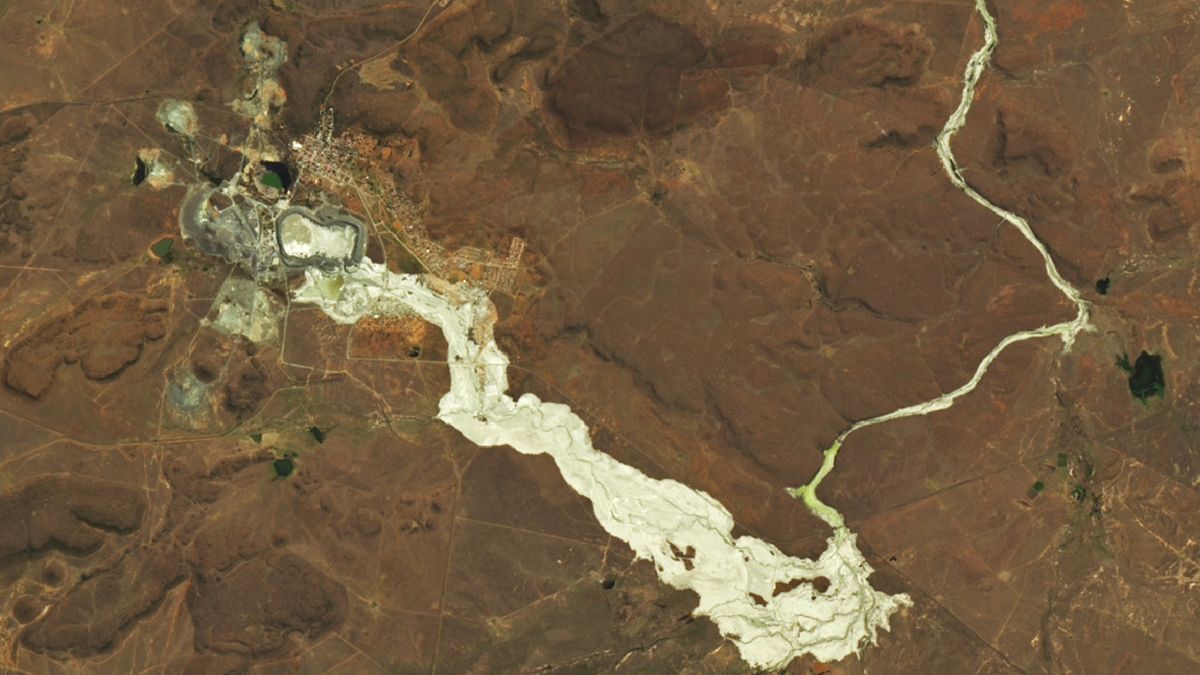QUICK FACTS
Where is it? Jagersfontein, South Africa [-29.77177410, 25.426807792]
What’s in the photo? A trail of golden mud winding like a river
Which satellite took the photo? Landsat 9
When was it taken? Oct. 4, 2022
This eerie satellite image shows a golden river of potentially toxic waste winding across the countryside after a deadly disaster at a diamond mine in South Africa.
On Sept. 11, 2022, a dam at a diamond mine in Jagersfontein suddenly collapsed, releasing a deluge of mining waste, known as tailings, which swept through the outskirts of the town and into the surrounding countryside, according to NASA’s Earth Observatory.
The disaster killed at least three people and injured around 40 others, Bloomberg reported at the time. The flooding also destroyed dozens of houses, damaged cell phone towers, shut down roads, temporarily polluted drinking water and washed away hundreds of sheep, Reuters reported.
In the photo, you can see the collapsed section in the south wall of the dam. From there, the tailings flowed down the hillside in a massive, 1-mile-wide (1.6 kilometers) wave that eventually funneled into the nearby Wolwas Dam before spilling over into the adjoining Prosesspruit river.
Another aerial image of the site taken the day before the disaster (see below) helps show the scale of the torrent that was unleashed.
Related: See all the best images of Earth from space
In total, the dried tailings covered around 10 square miles (26 square kilometers) of farmland. Parts of the Prosesspruit also appear to have widened, suggesting that the torrent of mining waste may have eroded away the river’s banks, according to the Earth Observatory.
It is unclear if any of the tailings remain in the area, but experts initially predicted that the dried waste would quickly crumble and either be blown away by wind or washed away by rain.
Toxic gold
Tailings are a muddy mix of dust, crushed rock, water and other byproducts left over from mining, according to Earthworks, a U.S.-based non-profit organization that supports communities impacted by mining and fossil fuel extraction.
The surplus slurry often contains trace quantities of metals, such as copper, mercury, cadmium and zinc, as well as other compounds, including petroleum, sulfuric acid and cyanide, according to Earthworks. This concoction makes the mixture appear gold when viewed from above, but also makes it potentially lethal to animals.
The diamond mine, once the deepest hand-excavated hole in the world, was also damaged from the flooding and has not reopened since the disaster. It is not clear if it ever will.
The mine produced two of the world’s eight largest diamonds — the Excelsior Diamond and the Reitz Diamond, also known as the Golden Jubilee Diamond, according to the Cape Town Diamond Museum.


